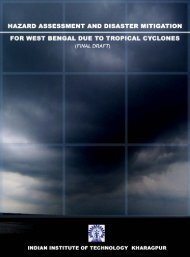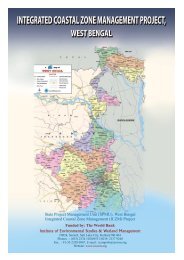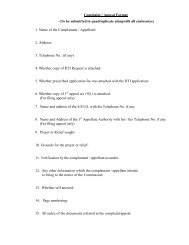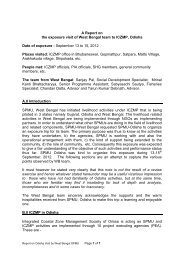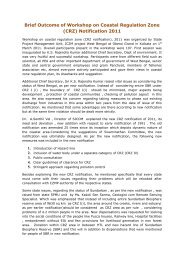INDIA: Integrated Coastal Zone Management Project
INDIA: Integrated Coastal Zone Management Project
INDIA: Integrated Coastal Zone Management Project
You also want an ePaper? Increase the reach of your titles
YUMPU automatically turns print PDFs into web optimized ePapers that Google loves.
<strong>INDIA</strong> <strong>Integrated</strong> <strong>Coastal</strong> <strong>Zone</strong> <strong>Management</strong> <strong>Project</strong> (P007985)<br />
First Implementation Support Mission, June 2011<br />
Activity Current Progress Agreed Next Steps & World Bank Recommendations<br />
Livelihood<br />
through<br />
Ecotourism at<br />
Sagar Island by<br />
the Sundarban<br />
Affairs<br />
Department<br />
(SAD)<br />
[4C-C3]<br />
provision of<br />
Cyclone<br />
Shelters in<br />
Sundarban by<br />
the Disaster<br />
<strong>Management</strong><br />
Department<br />
2. SAD officials have not retained any institutional memory of project<br />
preparation; and are therefore proposing activities and concepts which<br />
were rejected at preparation period of the project. The revised concepts<br />
and designs have not been prepared.<br />
3. No progress otherwise has been made.<br />
1. The Disaster <strong>Management</strong> Department has not signed MOU with the<br />
SPMU, but has nominated a senior officer as the nodal officer for the<br />
activities to be undertaken. The Disaster management Department has<br />
yet not opened the required bank account.<br />
2. No specific action has been undertaken to build the nascent capacity of<br />
the Disaster <strong>Management</strong> Department<br />
3. The proposal accepted at appraisal stage has been revised; the cost of<br />
one unit of cyclone shelter has been revised to RS.36.9 million instead<br />
of approximately Rs. 8 million at the time of appraisal. The new unit<br />
rate of construction is based on the States proposal under two other<br />
programs (PM Relief Fund and proposed National Cyclone Risk<br />
Mitigation <strong>Project</strong> – where the unit rate proposed by the State is<br />
Rs.38.6 million). The designs and estimates drew upon advice from an<br />
expert from IIT Kharagpur.<br />
4. Based on the above proposed rate escalation, the Disaster <strong>Management</strong><br />
Department has proposed to reduce the number of planned cyclone<br />
shelter to 10 from the original target of 32.<br />
5. No other progress has been made.<br />
are in place by September 2011, SPMU will undertake the work itself<br />
(the actual work will anyway be managed and operated by CBOs and<br />
Panchayats, as is currently planned).<br />
2. SPMU will need to support SAD to revise the proposal. SPMU will<br />
collect the plan and survey data already available with PHED (who<br />
oversee the annual fair at Gangasagar); and start planning and<br />
designing activities in conformity to that plan, but with an aim of<br />
environmental improvement of the area. SPMU will prepare an update<br />
and share with World Bank by October 2011. [Subject to Point 1<br />
above.]<br />
3. SPMU and SAD will revise and confirm the Annual Action Plan of<br />
2011-12 and 2012-13 by November 2011. [Subject to Point 1 above.]<br />
1. These actions need to be completed in August 2011.<br />
2. It is important for the State to build capacity for disaster management.<br />
The Department should prepare a proposal for building adequate<br />
capacity, using the current program of cyclone shelters as a base. The<br />
proposal should include how the other states such as Maharashtra,<br />
Tamil Nadu, Andhra Pradesh and Odisha and the like has built<br />
institutional capacity in the last decade; and what appropriate<br />
institutional models and elements should be replicated for West<br />
Bengal. This proposal should be internally agreed by the State, and<br />
shared with World Bank by March 2012. Based on this proposal<br />
approved by the State, initial institutional and capacity building<br />
activities should be included in the Annual Action Plan for 2012-13.<br />
3. This revision of cost is unacceptable to the World Bank. (A) The basic<br />
principle of constructing cyclone shelter is that creating a common<br />
facility has an economy of scale. Within the proposed unit cost of one<br />
cyclone shelter; around 300 households can be made cyclone proof,<br />
and if the cost of one unit of cyclone shelter is so high it might be<br />
rather appropriate and beneficial to use this money to retrofit a large<br />
number of houses. (B) The idea of very large size cyclone shelters, for<br />
either 2000 or 3000 persons is suspect. Such large size of cyclone<br />
shelters will mean that people at the time of cyclone have to travel<br />
long distances to reach the cyclone shelter. Also, land for construction<br />
of such large cyclone shelters is in short supply in the densely<br />
populated area. All cyclone shelters should usually be located in the<br />
53







